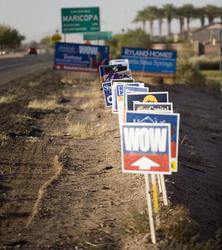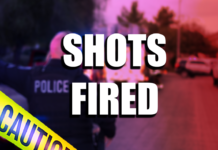Soon, a sign kiosk program may be turning its way in Maricopa.
A presentation of such a program was made at a recent Planning & Zoning Commission meeting.
According to P&Z Chairman Anthony Smith, the original idea behind the program was to “clean up” the abundance of homebuilding signs that so mark Maricopa (see related opinion). A drive into town makes it seem like Maricopa is home to every homebuilder in North America.
At the P&Z meeting earlier this month, Smith noted that the Commission took the position to recommend that council consider two options:
1. Add local businesses and non-profits to the sign kiosk program;
2. Suspend immediately the enforcement of the sign ordinance to businesses and non-profits until a similar solution can be formulated for them.
Shena Rojemann, a planner with the city of Maricopa, told inmaricopa.com that the sign kiosk program is being organized with a couple of goals in mind.
Among the goals are eliminating the sign pollution along roadways throughout the city and to serve as a directional tool for residents, visitors and possible future residents of the city. It is likely that businesses would be a great beneficiary of such a program.
“This program was delayed so as to coordinate with the branding effort,” Rojemann said. “At this point in time, the city is seeking to establish a ‘final design’ for the kiosk to get the system up and running as soon as possible. I say ‘final design’ because the kiosk’s design at this point are in no way an indication of the colors, style, or design, etc. for the final logo for the city of Maricopa. Once branding has completed their process, the kiosks will then be updated to compliment the new city of Maricopa logo.”
Rojemann added that the kiosk program is an effort between the city of Maricopa and the hired consultant, ALB Industries of Tempe.
“Once a ‘final design’ has been approved and the kiosk locations have been determined, it will take approximately two months to finalize the financial package to get the system up and running,” Rojemann commented.
Asked if other cities have such a program in place, Rojemann said there are various communities and counties throughout Arizona that have incorporated similar programs; including the city of Surprise, Pinal County and the Superstition Foothills area.
Look for more discussion on this issue when council next convenes in November.
Photo by Mandy Hank




![Alleged car thief released without charges Phoenix police stop a stolen vehicle on April 20, 2024. [Facebook]](https://www.inmaricopa.com/wp-content/uploads/2024/04/IMG_5040-218x150.jpg)
![Locals find zen with Earth Day drum circle Lizz Fiedorczyk instructs a drum circle at Maricopa Community Center April 22, 2024. [Brian Petersheim Jr.]](https://www.inmaricopa.com/wp-content/uploads/2024/04/PJ_3922-Enhanced-NR-218x150.jpg)










![Alleged car thief released without charges Phoenix police stop a stolen vehicle on April 20, 2024. [Facebook]](https://www.inmaricopa.com/wp-content/uploads/2024/04/IMG_5040-100x70.jpg)
![Locals find zen with Earth Day drum circle Lizz Fiedorczyk instructs a drum circle at Maricopa Community Center April 22, 2024. [Brian Petersheim Jr.]](https://www.inmaricopa.com/wp-content/uploads/2024/04/PJ_3922-Enhanced-NR-100x70.jpg)